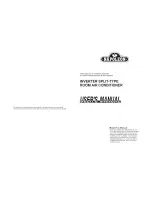
3
Refrigerants are heavier than air. They can "push out"
the oxygen in your lungs or in any enclosed space.To
avoid possible difficulty in breathing or death:
•
Never purge refrigerant into an enclosed room or
space. By law, all refrigerants must be reclaimed.
•
If an indoor leak is suspected, throughly ventilate the
area before beginning work.
• Liquid refrigerant can be very cold. To avoid possible
frostbite or blindness, avoid contact and wear gloves
and goggles. If liquid refrigerant does contact your
skin or eyes, seek medical help immediately.
• Always follow EPA regulations. Never burn refrig-
erant, as poisonous gas will be produced.
WARNING
To avoid possible explosion:
Never apply flame or steam to a refrigerant cylinder.
If you must heat a cylinder for faster charging,
partially immerse it in warm water.
Never fill a cylinder more than 80% full of liquid re-
frigerant.
• Never add anything other than R-22 to an R-22 cy-
linder . The service equipment used must be listed
or certified for the type of refrigerant used.
• Store cylinders in a cool, dry place. Never use a cy-
linder as a platform or a roller.
•
•
To avoid possible explosion, use only returnable (not
disposable) service cylinders when removing refrig-
erant from a system.
• Ensure the cylinder is free of damage which could
lead to a leak or explosion.
• Ensure the hydrostatic test date does not exceed
5 years.
• Ensure the pressure rating meets or exceeds 400
lbs.
When in doubt, do not use cylinder.
WARNING
Refrigerant Lines
The compressor mineral oil for R-22 units is susceptible to
moisture absorption and could cause compressor failure.
Do not leave system open to atmosphere any longer than
necessary for installation.
CAUTION
Use only refrigerant grade (dehydrated and sealed) copper tub-
ing to connect the condensing unit with the indoor evaporator.
After cutting the tubing, install plugs to keep refrigerant tubing
clean and dry prior to and during installation. Tubing should
always be cut square keeping ends round and free from burrs.
Clean the tubing to prevent contamination.
Do NOT let refrigerant lines come in direct contact with plumb-
ing, ductwork, floor joists, wall studs, floors, and walls. When
running refrigerant lines through a foundation or wall, openings
should allow for sound and vibration absorbing material to be
placed or installed between tubing and foundation. Any gap
between foundation or wall and refrigerant lines should be filled
with a pliable silicon-based caulk, RTV or a vibration damping
material. Avoid suspending refrigerant tubing from joists and
studs with rigid wire or straps that would come in contact with
the tubing. Use an insulated or suspension type hanger. Keep
both lines separate and always insulate the suction line.
These sizes are recommended for line lengths of 79 feet or
less. For other line sizing option or runs of more than fifty feet,
refer to Remote Cooling Service Manual, or TP-106 Long Line
Set Application R-22, or contact your distributor for assistance.
Cond
Unit
Tons
Suct
Liq
Suct
Liq
Suct
Liq
1 1/2
5/8
1/4
3/4
3/8
3/4
3/8
2
5/8
1/4
3/4
3/8
3/4
3/8
2 1/2
5/8
1/4
3/4
3/8
7/8
3/8
3
3/4
3/8
7/8
3/8
1 1/8
3/8
3 1/2
7/8
3/8
1 1/8
3/8
1 1/8
3/8
4
7/8
3/8
1 1/8
3/8
1 1/8
3/8
5
7/8
3/8
1 1/8
3/8
1 1/8
3/8
Line Diameter (In. OD)
RECOMMENDED INTERCONNECTING TUBING (Ft)
0-24
25-49
50-79*
* Lines greater than 79 feet in length or vertical elevation
changes more than 50 feet
refer to the Rem ote Cooling
Service Manual or contact your distributor for assistance.






























